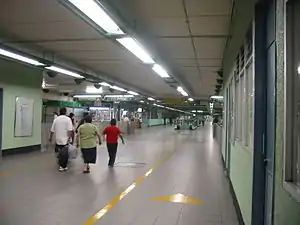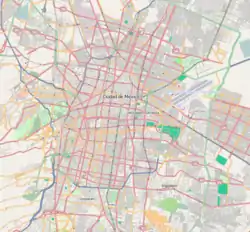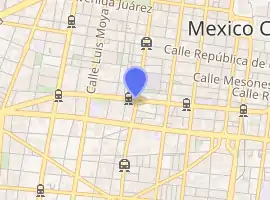Salto del Agua metro station
Salto del Agua is a metro (subway) station on the Mexico City Metro. It is located in the Cuauhtémoc borough in the center of Mexico City.
Name and iconography
Its logo represents the Salto del Agua fountain. This fountain is at the end of the old Chapultepec Aqueduct, also known as the Belen aqueduct. This aqueduct ran from what is now Chapultepec Park, following Chapultepec Avenue and Arcos de Belen (Arches of Belen) Streets ending at this fountain. It lies on the border of the historic center, Colonia Doctores and Colonia Obrera. Contrary to popular belief, this fountain is not the original but rather a reproduction. The original fountain had deteriorated significantly, so architect Guillermo Ruiz was tasked with its reproduction, using the original engraved stone epigraphs as a model. What is left of the original fountain is in the National Museum of the Viceregal Period in Tepotzotlán.[2]
General information
Salto del Agua is a transfer station and contains a cultural display. It also has two kinds of architecture, one from Line 1 of the Metro, and the other, more modern style, of Line 8. Line 8 exits connect with Eje Central, which is filled in this zone with bookstores, boutiques, electronics shops, and street traders, locally known as vendedores ambulantes or "ambulantaje".
Metro Salto del Agua also transfers to trolleybus line "A", which runs the full length of Eje Central Lázaro Cárdenas and more, from Metro Autobuses del Norte and Metro Tasqueña – the city's main north and south intercity bus stations.
Inside the station is a mural entitled The Three Workers by artist Jason Schell.
Ridership
| Annual passenger ridership (Line 1) | |||||
|---|---|---|---|---|---|
| Year | Ridership | Average daily | Rank | % change | Ref. |
| 2021 | 4,369,643 | 11,971 | 67/195 | −9.29% | [1] |
| 2020 | 4,817,210 | 13,161 | 62/195 | −35.62% | [3] |
| 2019 | 7,482,564 | 20,500 | 86/195 | +0.34% | [4] |
| 2018 | 7,457,088 | 20,430 | 87/195 | −2.65% | [5] |
| 2017 | 7,660,338 | 20,987 | 83/195 | −11.79% | [6] |
| 2016 | 8,684,401 | 23,727 | 65/195 | −2.70% | [7] |
| 2015 | 8,925,514 | 24,453 | 61/195 | −2.46% | [8] |
| 2014 | 9,151,061 | 25,071 | 60/195 | −4.19% | [9] |
| 2013 | 9,550,935 | 26,166 | 59/195 | −6.76% | [10] |
| 2012 | 10,243,910 | 27,998 | 53/195 | +18.93% | [11] |
| 2011 | 8,613,710 | 23,599 | 78/175 | +10.21% | [12] |
| 2010 | 7,815,475 | 21,412 | 68/175 | – | [13] |
| Annual passenger ridership (Line 8) | |||||
|---|---|---|---|---|---|
| Year | Ridership | Average daily | Rank | % change | Ref. |
| 2021 | 3,098,577 | 8,489 | 106/195 | +5.12% | [1] |
| 2020 | 2,947,538 | 8,053 | 118/195 | −45.96% | [3] |
| 2019 | 5,454,216 | 14,943 | 120/195 | −2.65% | [4] |
| 2018 | 5,602,459 | 15,349 | 118/195 | −6.05% | [5] |
| 2017 | 5,963,274 | 16,337 | 110/195 | −11.13% | [6] |
| 2016 | 6,709,999 | 18,333 | 100/195 | +0.65% | [7] |
| 2015 | 6,666,917 | 18,265 | 99/195 | −3.68% | [8] |
| 2014 | 6,921,771 | 18,963 | 95/195 | −1.08% | [9] |
| 2013 | 6,997,398 | 19,170 | 98/195 | +30.66% | [10] |
| 2012 | 5,355,424 | 14,632 | 122/195 | −17.11% | [11] |
| 2011 | 6,460,539 | 17,700 | 112/175 | +3.52% | [12] |
| 2010 | 6,240,607 | 17,097 | 92/175 | – | [13] |
Exits
Line 8
- Northeast: Eje Central Lázaro Cárdenas and Plaza de las Vizcainas, Centro
- Northwest: Eje Central Lázaro Cárdenas and Delicias street, Centro
References
- "Afluencia de estación por línea 2021" [Station traffic per line 2021] (in Spanish). Sistema Transporte Colectivo Metro. 2022. Archived from the original on 7 March 2022. Retrieved 7 March 2022.
- Prado Nuñez, Ricardo (1965). Catalogo de Monumentos Escultoricos y Conmemorativos del Distrito Federal (in Spanish). p. 20.
- "Afluencia de estación por línea 2020" [Station traffic per line 2020] (in Spanish). Sistema Transporte Colectivo Metro. 2021. Archived from the original on 21 June 2021. Retrieved 21 June 2021.
- "Afluencia de estación por línea 2019" (in Spanish). Sistema Transporte Colectivo Metro. 2020. Archived from the original on 8 April 2020. Retrieved 3 May 2020.
- "Afluencia de estación por línea 2018" (in Spanish). Sistema Transporte Colectivo Metro. 2019. Archived from the original on 6 June 2019. Retrieved 7 April 2020.
- "Afluencia de estación por línea 2017" (in Spanish). Sistema Transporte Colectivo Metro. 2019. Archived from the original on 3 May 2020. Retrieved 3 May 2020.
- "Afluencia de estación por línea 2016" (in Spanish). Sistema Transporte Colectivo Metro. 2017. Archived from the original on 3 May 2020. Retrieved 3 May 2020.
- "Afluencia de estación por línea 2015" (in Spanish). Sistema Transporte Colectivo Metro. 2016. Archived from the original on 3 May 2020. Retrieved 6 May 2020.
- "Afluencia de estación por línea 2014" (in Spanish). Sistema Transporte Colectivo Metro. 2015. Archived from the original on 3 May 2020. Retrieved 6 May 2020.
- "Afluencia de estación por línea 2013" (in Spanish). Sistema Transporte Colectivo Metro. 2014. Archived from the original on 3 May 2020. Retrieved 6 May 2020.
- "Afluencia de estación por línea 2012" (in Spanish). Sistema Transporte Colectivo Metro. 2013. Archived from the original on 3 May 2020. Retrieved 6 May 2020.
- "Afluencia de estación por línea 2011" (in Spanish). Sistema Transporte Colectivo Metro. 2012. Archived from the original on 6 May 2020. Retrieved 6 May 2020.
- "Afluencia de estación por línea 2010" (in Spanish). Sistema Transporte Colectivo Metro. 2011. Archived from the original on 6 May 2020. Retrieved 6 May 2020.


